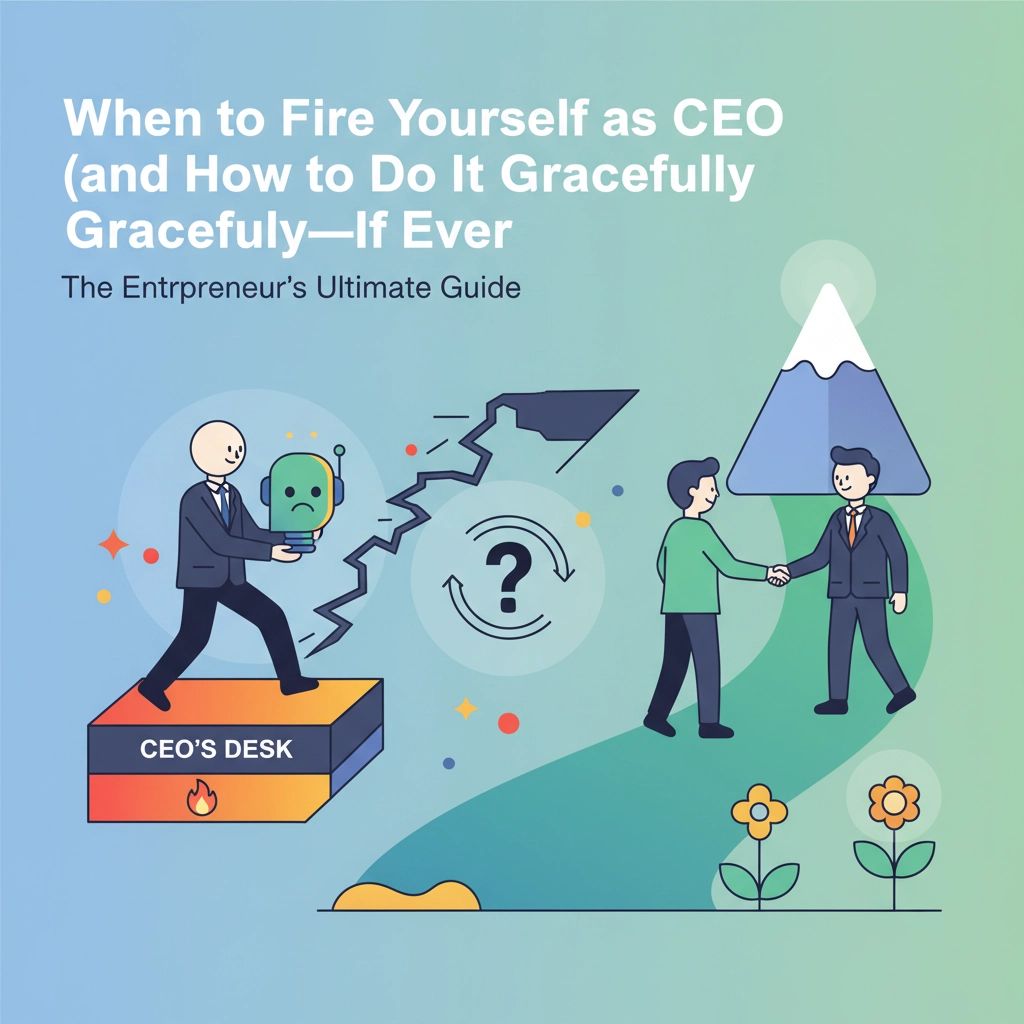When to Fire Yourself as CEO (and How to Do It Gracefully: If Ever)
Nov 19, 2025
Here's a counterintuitive thought: the best CEOs know when to fire themselves.
As a technical founder in deeptech or healthtech, you probably didn't start your company planning your own exit from the CEO role. But here's the reality: most successful startups naturally outgrow their founding leadership. The question isn't if this might happen, but when and how you'll handle it.
In our latest Deeptech Insider #27, we explored the identity crisis that hits many founders: should you ever step aside? The answer isn't simple, but it starts with brutal self-honesty about your evolving role.
The Hard Truth About Founder CEOs
Let's get the statistics out of the way first. More than 50% of founders are replaced by the third round of financing. Even more sobering: 73% of replaced founders are fired by their Board of Directors rather than choosing to step down voluntarily.
But here's where it gets interesting: when founders voluntarily step down, they stay on the company board 96% of the time, or transition into a different executive role 37% of the time. The founders who get forced out? They rarely maintain meaningful involvement with the companies they built.
This distinction matters enormously, especially in deeptech and healthtech where your technical expertise and industry relationships remain valuable even if your day-to-day leadership role needs to evolve.

When Your Technical Expertise Becomes a Limitation
For deeptech and healthtech founders, the transition challenge is particularly complex. Your deep technical knowledge got you this far: it's probably the foundation of your entire value proposition. But that same expertise can become a constraint as your company scales.
Here are the warning signs that it might be time to consider stepping back:
You're Still in the Weeds Instead of Leading Strategy
If you're still the person diving deepest into R&D decisions, regulatory pathways, or technical architecture while your team waits for strategic direction, that's a red flag. A scaling deeptech company needs a CEO who can think systems-wide, not just technically deep.
Your Network Has Plateaued
In healthtech especially, relationships with key opinion leaders, regulatory bodies, and strategic partners often determine success. If your network isn't expanding at the pace your company needs, or if you're not the right person to open doors at the next level, that's worth honest evaluation.
You're Avoiding the Business Side
Many technical founders excel at building products but struggle with scaling operations, managing complex sales cycles, or navigating late-stage investor expectations. If you find yourself consistently delegating or avoiding these areas rather than developing competency, consider whether someone else might be better positioned to lead.
The Burnout Signal
Sometimes the clearest indicator is how you feel. As we covered in our burnout post, founder fatigue isn't just about working too many hours: it's about feeling misaligned with your role's demands. If you're consistently dreading aspects of the CEO job that should energize you, pay attention to that signal.
How to Fire Yourself Gracefully
If you've recognized some warning signs, here's how to approach this transition strategically rather than waiting for someone else to make the decision for you.
Start With Radical Self-Assessment
Create psychological safety for yourself and your team to have honest conversations about your performance. Ask your board, co-founders, and direct reports: "Where can I improve?" and "Am I the right person to take this company to the next level?"
Don't fire yourself in a vacuum: this decision affects everyone. Get feedback, but be prepared to hear things that might sting.
Reframe the Narrative
This isn't about failure. You've successfully guided your company from concept to its current state. That's an achievement worth celebrating. View stepping down not as defeat but as strategic succession planning: something every successful company needs.
For deeptech and healthtech companies specifically, your transition can actually unlock value. The right operational CEO might accelerate partnerships, fundraising, or market expansion in ways your technical background couldn't.

Build Your Support System
Don't navigate this alone. Find an executive coach, advisor, or even therapist who can help you process both the exit from your current role and the transition to what comes next. Many technical founders underestimate the identity shift involved in stepping back from the CEO role.
The sooner you start these conversations, the more control you maintain over the process.
Design Your Future Role Thoughtfully
Just because you're stepping back from CEO doesn't mean you're leaving the company. Many successful transitions involve founders moving into CTO, Chief Scientific Officer, or Executive Chairman roles. Others join the board while pursuing new ventures.
Think about where your unique value: technical expertise, industry relationships, company knowledge: can still contribute most effectively. This might be choosing the right board composition or staying involved in product strategy while handing off operations.
Create a Timeline That Works
Some leaders fire and rehire themselves every six months; others prefer annual reviews. For deeptech and healthtech companies, consider aligning these assessments with major milestones: product launches, funding rounds, regulatory approvals, or partnership developments.
The key is making this evaluation routine rather than crisis-driven. Regular assessment removes the emotional weight and helps you stay ahead of misalignment.
The Proactive Approach
One former CEO shared that even after increasing stock value by 500%, he realized he'd become too embedded in everything. Knowing too much had actually become a disadvantage: he was bottlenecking decisions and limiting his team's growth.
He made the difficult decision to fire himself intentionally rather than wait for the board to make that decision for him.
This approach: mentally firing yourself and your team every year, then rehiring based on what the next set of challenges requires: prevents organizational stagnation. It ensures continuous alignment between leadership capabilities and company needs.
For technical founders, this is particularly important because the skills that get you to product-market fit often differ from those needed to scale commercially or navigate late-stage growth.

Making the Transition Stick
If you decide to step down, do it with dignity. Put your energy into finding and supporting your successor. Stay involved in ways that add value rather than creating confusion about who's really in charge.
Remember: companies that stagnate typically do so because the playbook that got them there no longer fits their current reality, but the leadership structure never adapted to reflect that shift.
Your job as a founder isn't to hold onto the CEO title forever: it's to do whatever helps your company succeed. Sometimes that means recognizing when someone else can take it further than you can.
The Bottom Line
Firing yourself isn't giving up: it's strategic leadership. It's choosing to maintain control over your transition rather than having it imposed on you. It's recognizing that building a successful company sometimes means stepping back from running it day-to-day.
For deeptech and healthtech founders especially, your technical expertise and industry knowledge remain valuable assets regardless of your formal title. The question isn't whether you'll always be CEO, but how you'll evolve your role to keep driving your company's mission forward.
The founders who handle this transition best are those who make it proactive rather than reactive. They regularly assess their fit, build systems for honest feedback, and stay open to the possibility that stepping back might be the best way to move forward.
That takes courage. But then again, so did starting the company in the first place.